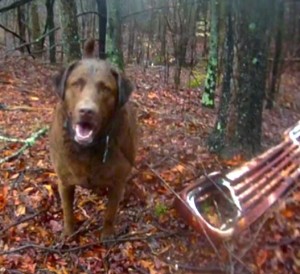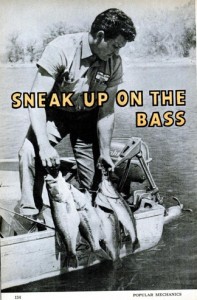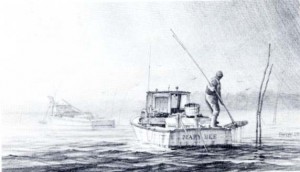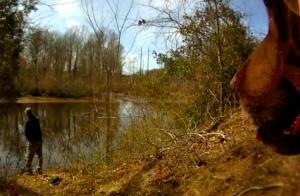 If you’ve looked down at the water flowing beneath the Chesapeake Bay Bridge recently you’ve surely noticed that it’s the color of butterscotch syrup. According to the Maryland Department of Natural Resources, the flow over the Conowingo Dam on March 12 was the highest since Tropical Storm Ivan in 2004. Water clarity is worse than it’s been in recorded history. We’re currently experiencing an annual event called the freshet. Although I never heard the term before I moved to this region, I now know that a freshet occurs in saltwater estuaries when spring rains and snow-melt cause upstream rivers to flood. This results in the additional flow of hundreds of billions of gallons of muddy, sediment-saturated water into the Bay. The map on the left is a NASA satellite photo of the Chesapeake region taken this week. I’ve labeled a few places for reference. It shows a plume of muddy water flowing from the Susquehanna River south though the main stem of the Bay to the mouth of the Potomac River. Note that the water is muddiest in the area between the Susquehanna Flats and the Bay Bridge.
If you’ve looked down at the water flowing beneath the Chesapeake Bay Bridge recently you’ve surely noticed that it’s the color of butterscotch syrup. According to the Maryland Department of Natural Resources, the flow over the Conowingo Dam on March 12 was the highest since Tropical Storm Ivan in 2004. Water clarity is worse than it’s been in recorded history. We’re currently experiencing an annual event called the freshet. Although I never heard the term before I moved to this region, I now know that a freshet occurs in saltwater estuaries when spring rains and snow-melt cause upstream rivers to flood. This results in the additional flow of hundreds of billions of gallons of muddy, sediment-saturated water into the Bay. The map on the left is a NASA satellite photo of the Chesapeake region taken this week. I’ve labeled a few places for reference. It shows a plume of muddy water flowing from the Susquehanna River south though the main stem of the Bay to the mouth of the Potomac River. Note that the water is muddiest in the area between the Susquehanna Flats and the Bay Bridge.
Although the freshet occurs every spring, there is more flow in some years than others. During an average year, about two and a half billion pounds of sediment wash down the Susquehanna into the Bay. In very wet years it can be twice that. It remains to be seen how this spring will turn out, but for now things are above normal. Since there is research proving striped bass spawn more productively in fresher water, the news is both good and bad for fishing. Read More!
 This is the time of year I like to walk along Tuckahoe Creek near Queen Anne, Maryland casting for perch and chain pickerel. For the past couple of years I’ve only caught white perch on the Tuckahoe. I’ve missed the earlier yellow perch spawn because it frequently coincides with the first wave of pre-spawn rockfish. I thought I might miss it again this year, but today’s rainy windy weather kept me off the Bay. My four-year-old Chesapeake Bay Retriever Crockett and I left Kent Island about noon and took the long way around before parking the truck and hiking in to my favorite perch holes. The rain poured and the fish bit. It wasn’t hot and heavy like I’ve been hearing about in the Western Shore creeks, but I finished up with six keepers out of a couple dozen perch, and released a nice pickerel. My lure was a chartreuse one-thirty-second ounce feather fly tied by my Severn River Rod & Keg Club brother Woody of Maryland Tackle. I jigged it under a tiny green top float. A feather fly coupled with a buoyant, lively float is a combination my dad taught me. My brother Creig has been wearing out the crappie in the TVA lakes using it. It’s a very specific technique because any old float won’t work. I think I’ll keep the brand name to myself for now, but you might be able to figure it out from the video. It was great to get out and stream fish for a while. I’ll visit the Tuckahoe again once the white perch run begins. As you can tell, Crockett is in his element in the rainy woods. Read More!
This is the time of year I like to walk along Tuckahoe Creek near Queen Anne, Maryland casting for perch and chain pickerel. For the past couple of years I’ve only caught white perch on the Tuckahoe. I’ve missed the earlier yellow perch spawn because it frequently coincides with the first wave of pre-spawn rockfish. I thought I might miss it again this year, but today’s rainy windy weather kept me off the Bay. My four-year-old Chesapeake Bay Retriever Crockett and I left Kent Island about noon and took the long way around before parking the truck and hiking in to my favorite perch holes. The rain poured and the fish bit. It wasn’t hot and heavy like I’ve been hearing about in the Western Shore creeks, but I finished up with six keepers out of a couple dozen perch, and released a nice pickerel. My lure was a chartreuse one-thirty-second ounce feather fly tied by my Severn River Rod & Keg Club brother Woody of Maryland Tackle. I jigged it under a tiny green top float. A feather fly coupled with a buoyant, lively float is a combination my dad taught me. My brother Creig has been wearing out the crappie in the TVA lakes using it. It’s a very specific technique because any old float won’t work. I think I’ll keep the brand name to myself for now, but you might be able to figure it out from the video. It was great to get out and stream fish for a while. I’ll visit the Tuckahoe again once the white perch run begins. As you can tell, Crockett is in his element in the rainy woods. Read More!
 “Show me a fisherman and I’ll show you a scoundrel and a sneak,” says well-known outdoor writer Bob Lawless. I don’t hang out with too many scoundrels, but every good fisherman I know is a sneak. In an article about newly-invented trolling motors, the April 1960 edition of Popular Mechanics offers this observation: “Big fish don’t get to be bigger fish by being dumb. They get big by learning to recognize predators in their midst.” Stealth is one of fishing’s primary skills.
“Show me a fisherman and I’ll show you a scoundrel and a sneak,” says well-known outdoor writer Bob Lawless. I don’t hang out with too many scoundrels, but every good fisherman I know is a sneak. In an article about newly-invented trolling motors, the April 1960 edition of Popular Mechanics offers this observation: “Big fish don’t get to be bigger fish by being dumb. They get big by learning to recognize predators in their midst.” Stealth is one of fishing’s primary skills.
By swimming and scuba diving I’ve learned that some sounds are easily transferred through the water. Surface conversations can be heard down to about fifteen feet while the thump of loud music or an object falling onto the deck of a boat can be detected even deeper. The most recognizable underwater noise is made by running outboards and whirling props.
Some fishermen are so careful about noise that they won’t even turn on their sonar units when they know they’re over fish. It’s been proven that fish can detect the pings. I’m not always that sneaky, but I’ve learned a little something over the years about how important stealth can be. Take a look at the monster light tackle stripers in this report and you’ll see what I mean!
 Like any kid, I had heroes. I guess mine were a little grittier than the usual collection of sports figures and cowboy stars. Charlie Lawson wore a red Allis Chalmers baseball cap and ran lines below Three Springs Bluff. Cab Jarnigan rolled his own cigarettes and once caught a hundred-pound paddlefish. Gus Isom lived up on the hill behind my dad’s dock and built his own boats. All my heroes were commercial fishermen.
Like any kid, I had heroes. I guess mine were a little grittier than the usual collection of sports figures and cowboy stars. Charlie Lawson wore a red Allis Chalmers baseball cap and ran lines below Three Springs Bluff. Cab Jarnigan rolled his own cigarettes and once caught a hundred-pound paddlefish. Gus Isom lived up on the hill behind my dad’s dock and built his own boats. All my heroes were commercial fishermen.
When I first learned it was possible to make a living catching fish I thought it was the coolest thing I’d ever heard. Imagine a job where one could spend every day in a boat, on the water, FISHING! I idolized the commercial guys, watched every move they made, and longed to someday take a place beside them on the water. When I was old enough, Gus Isom took me under his wing and taught me how to run trotlines for catfish. A year later I was ready to try it on my own. I’ll never forget the day the mailman delivered a package labeled “Official Business – Tennessee Wildlife Resource Agency.” My hands were shaking so bad I could hardly rip open the padded manila envelope, and I strutted around like a banty rooster when I saw my name engraved on the steel trotline tags. I could now join my heroes. It was the greatest accomplishment of my sixteen-year-old life. Read More!
 On the margin of the river,
On the margin of the river,
Washing up its silver spray,
We will talk and worship ever,
All the happy golden day. – from Shall we Gather at the River, Robert Lowery, 1864
With Stevensville church bells ringing in the distance, we pulled into the parking lot at the Kent Narrows boat ramp about 11:00 AM. I always feel a little bad about fishing on Sunday mornings. My father was a Church of Christ minister who preached for a small Appalachian congregation in the Clinch mountain highlands near Sneedville, Tennessee. Needless to say, when I was a kid we went to church every time the doors opened. Dad was also one of the best bass fishermen in the Southeast. When the bass pros came to fish the big tournaments, he was the first person they contacted. People said he was a fisher of fish and a fisher of men. It wasn’t unusual to see him fishing in a suit and tie before or after church services, but we never missed church.



